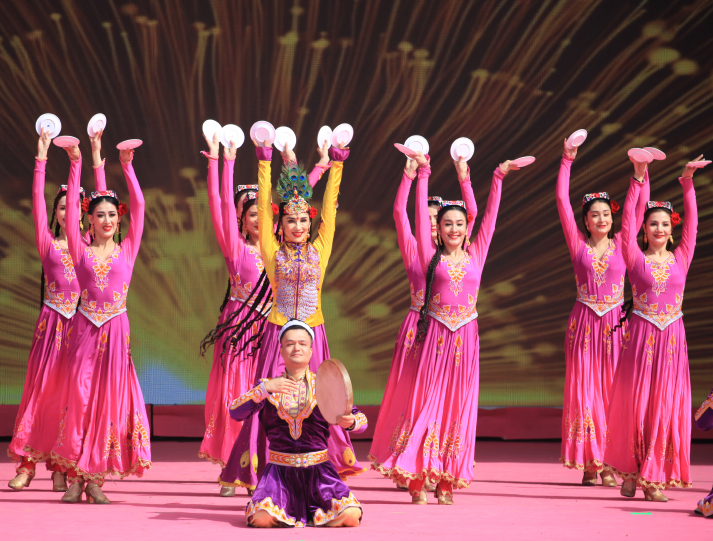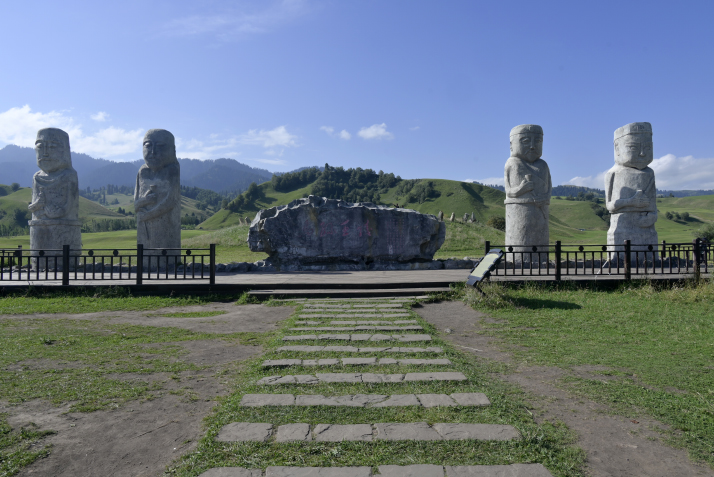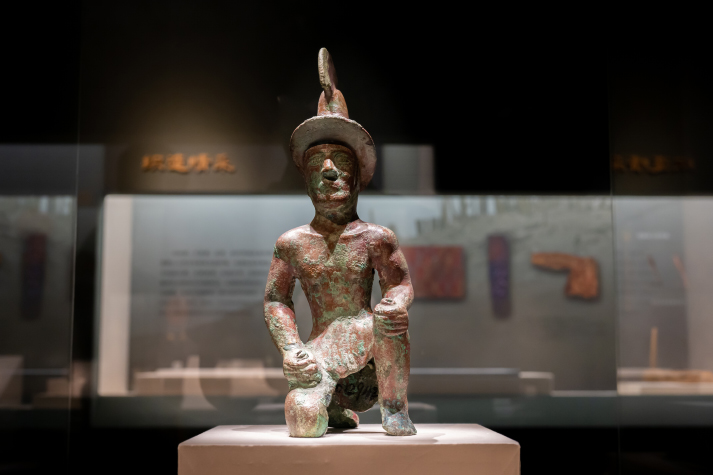| Xinjiang Today |
| Who were Xinjiang's earliest inhabitants? | |
|
|
 A Uygur dance performance in Tuokexun (Toksun) County, Turpan City, on March 22 (VCG)
Xinjiang has been a multiethnic region since antiquity. According to the Seventh National Census data released by the region's authorities, as of November 1, 2020, the majority of Xinjiang's permanent population consisted of Uygurs and Han Chinese, accounting for 44.96 percent and 42.24 percent of the total, respectively. The ethnic identities of the region's earliest inhabitants were first clearly documented during the Han Dynasty (206 B.C.-A.D. 220). Notably, the earliest residents were not Uygurs, but rather peoples such as the Sai, Rouzhi, Wusun, Qiang, Xiongnu and Han. Among these groups, only the Han and Qiang have persisted to the present day.  A mausoleum of a Wusun king in Nalati (Narat) Grassland, Ili Kazak Autonomous Prefecture (VCG)
Early residents The Book of Han, a classic covering the history of the Western Han Dynasty (206 B.C. to A.D. 25), mentions the Sai, a now largely unfamiliar group. According to the book, the Darouzhi, a branch of the Rouzhi people, defeated the Sai king and took over his territory, forcing the Sai people to move south. This territory was later seized by the Wusun king. These events took place around the second century B.C. in the land now believed to be in the Ili River region of modern-day Xinjiang and the Chu River region in today's Kyrgyzstan and Kazakhstan, then part of China's Western Regions. This is the earliest recorded account of the ethnic groups living in Xinjiang. The Sai people, known as Scythians in Greek historical accounts, were scattered across the Eurasian grasslands, with some tribes living in the Western Regions. At that time, the region was home to over a dozen ethnic groups, according to the Book of Han. According to historical records, the Qiang people originally inhabited the middle and upper reaches of the Yellow River in northwest China. During the Spring and Autumn period (770-476 B.C.), some of them migrated westward to Xinjiang. Ancient Chinese texts such as the Book of Han indicate that present-day Yecheng County, Kashi (Kashgar) Prefecture, was a primary territory of the Qiang people. The Book of the Later Han, which covers the history of the Eastern Han Dynasty (25-220), said the Qiang mainly engaged in herding and hunting in the Western Regions. Most Xiongnu people entered Xinjiang around 176 B.C. After being defeated in prolonged wars with the Han Dynasty, they were forced to leave the Western Regions in 60 B.C. That same year, the Han court established the Western Regions Frontier Command to govern the area now known as Xinjiang. The Han people were also among the earliest ethnic groups to enter Xinjiang. In 101 B.C., the Han military began cultivating farmland in areas such as Luntai, eventually expanding across the region. These military farms were the initial settlements of Han people in Xinjiang. After the establishment of the Western Regions Frontier Command, Han people continued to arrive in Xinjiang for various reasons, including serving as officials, joining the military or engaging in trade. Over the following millennium, many ancient ethnic groups came to Xinjiang, including the Rouran, Gaoche and Ouigour. These groups frequently moved about and interacted. After the 1760s, to further strengthen Xinjiang's frontier defenses, the Qing Dynasty (1644-1911) relocated officials and soldiers from the Manchu, Xibe and Ewenki ethnic groups from northeast China to Xinjiang in the northwest. These groups became new ethnic minorities in Xinjiang. Later, other ethnic groups, including the Russians and Tatars, also migrated here. By the end of the 19th century, Xinjiang was home to 13 major ethnic groups: Uygur, Han, Kazak, Mongolian, Hui, Kirgiz, Manchu, Xibe, Tajik, Daur, Uzbek, Tatar and Russian. All of them contributed to the development of Xinjiang.  A bronze statue dating back to the Warring States period (475-221 B.C.), unearthed in Xinyuan County, Ili Kazak Autonomous Prefecture, in 1983. It is believed to represent a Sai warrior (VCG)
Uygur ancestors The main ancestors of the Uygurs were the Ouigour people who lived on the Mongolian Plateau during the Sui and Tang dynasties (581-907). Many different names were used in historical records to refer to this group of people. To resist oppression and slavery by the Turks, who were then a leading power in the region, the Ouigour people united with some of the Tiele tribes to form the Ouigour tribal alliance. In 744, the Tang court conferred a title on Kutlug Bilge Khagan, who united the Ouigour tribes. In 788, the then Ouigour ruler wrote to the Tang emperor, requesting to have their name changed to "Uighur." After the Uighur Khanate was defeated by the Kyrgyz people in 840, some of the Uighurs moved eastward to live with the Han people, and the rest were divided into three sub-groups. One of the sub-groups moved to the Turpan Basin and the present-day Jimusaer (Jimsar) region, where they founded the Uighur Kingdom of Gaochang. Another moved to the Hexi Corridor, a 1,000-km corridor spanning today's Gansu Province and a key segment of the Silk Road, where they merged with local ethnic groups to become what was later known as the Yugurs. The third sub-group became scattered in the areas from Central Asia to today's Kashi, and joined the Karluk and Yagma peoples in founding the Kara-Khanid Khanate. The Uighurs merged with the Han people in the Turpan Basin and the Yanqi, Qiuci, Shule and other peoples in the Tarim Basin to form the major part of the modern Uygur ethnic group. In the Yuan and Ming dynasties (1279-1644), the various ethnic groups in Xinjiang further merged. The Mongolians, especially those of the Chagatai Khanate, became fused with the Uygurs, adding fresh blood to the Uygur group. By the end of the 19th century, the Uygur had become the most populous ethnic group in Xinjiang. In 1934, Xinjiang issued a government order, stipulating that Weiwuer would be the standard Chinese name for Uygurs, which for the first time defined the meaning of Weiwuer (Uygur): maintaining unity among the people. Xinjiang Uygur Autonomous Region was officially established on October 1, 1955. The Uygur is not the sole principal ethnic group in Xinjiang, and therefore the inclusion of Uygur in the name of the autonomous region is not exclusive. Xinjiang also contains administrative divisions such as Ili Kazak Autonomous Prefecture and Changji Hui Autonomous Prefecture, reflecting the protection of the rights of other ethnic groups. Moreover, as defined in 1934, the term Weiwuer (Uygur) means "maintaining unity among the people," embodying the spirit of harmony, stability and prosperity. While acknowledging the cultural centrality of the Uygur people in Xinjiang, the institutional design also ensures the unity and inclusiveness of a multiethnic nation. |
|
||||||||||||||||||||||||||||
|
